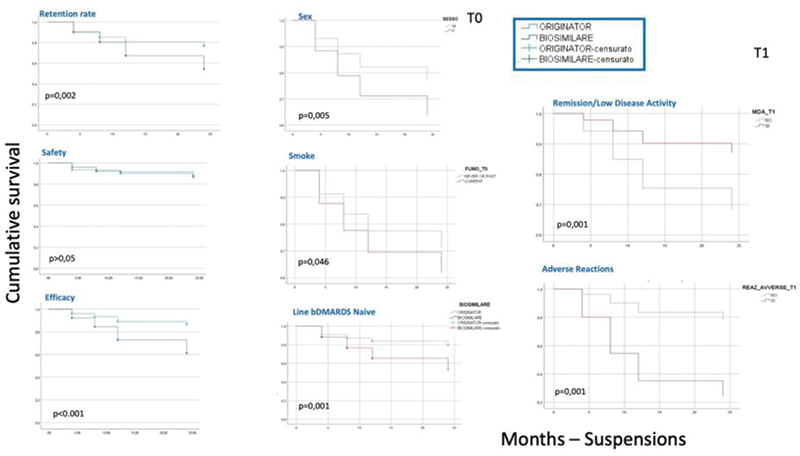

Background: Tumor necrosis factor (TNF)-α is one of principal proinflammatory cytokines involved in pathogenesis of different inflammatory arthropathies as Rheumatoid Arthritis (RA), Psoriatic Arthritis (PsA) and Ankylosing Spondylitis (AS). Biotechnological drugs, represented among others by monoclonal antibodies directed against TNF-α, lead to a revolution in RA and spondylarthritis treatment. They were the first biological drugs used to treat these diseases, with good results in terms of safety and efficacy. Also because of high cost of these drugs, for some years biosimilars have been introduced in clinical practice. Biosimilars are less expensive (in Italy, less of 30% than bioriginators); they underwent to a severe process of “ comparability ” to assess safety and efficacy like their originators. In Italy, AIFA authorized SB4 (etanercept biosimilar), SB5 and ABP501 (adalimumab biosimilars) after passing III-phase randomized clinical trials; but real-life data and registers are lacking.
Objectives: Aim of this study is to compare biosimilars and bioriginators in terms of safety and efficacy in a real-life contest.
Methods: We consequently enrolled patients, affected by inflammatory arthropathies (RA, PsA, AS) and treated with biosimilars (SB4, ABP501), belonging to any of the main biological prescribing centers in the Lazio region, from 2017 to 2020. Moreover, we enrolled patients, affected by same inflammatory diseases, but treated with corresponding originator. Clinical and laboratory data as well as disease activity indices, were collected at recruitment (T0) and after 4 (T1), 8 (T2), 12 (T3) and 24 (T4) months of therapy. Adverse events were registered.
Results: The multicenter cohort was composed by 455 patients treated with biosimilars (SB4/ABP501 276/179; F/M 307/146; naïve 56%, median age/IQR 55/46-65) and 436 treated with originators (etanercept/adalimumab 186/259, F/M 279/157, naïve 67,2%, median age/IQR 53/43-62). No differences were found about safety, but biosimilar group presented a higher number of discontinuations due to inefficacy (p<0.001), observed at all time-points. Female gender, to be smoker and b-DMARDs naïve, the initial non-response to the drug were predictive factors of reduced drug survival (p=0,05, p=0,046, p=0,001 respectively). Retention rate at 24 months was 81.1% for bioriginators and 76.5% for biosimilars (with a median retention time of 20.7 and 18.9 months, respectively) (p=0.002). Patients with remission/low disease activity achievement at T1 showed a cumulative survival of 90% to biosimilar therapy until at T4 (p=0.001); early adverse reactions instead represented an important cause of subsequent drug discontinuation (p=0.001).
Conclusion: Real-life data demonstrated the same safety between biosimilars and originators but a reduced biosimilar retention rate at 24 months, about 76%. Despite their loss efficacy, biosimilars could be considered valid and safe, and a good and less expensive alternative to the originators, allowing access to these innovative treatments to a wider patient population.
REFERENCES:
[1]Feldmann, M. & Maini, R. N. Anti-TNFα therapy of rheumatoid arthritis: what have we learned? Annu. Rev. Immunol. 2001;19, 163–196.
[2]McInnes IB, Schett G (2007) Cytokines in the pathogenesis of rheumatoid arthritis. Nat Rev Immunol 7:429–442
[3]Velayudhan J, Chen YF, Rohrbach A, Pastula C, Maher G, Thomas H, et al. Demonstration of functional similarity of proposed biosimilar ABP 501 to adalimumab. BioDrugs. 2016;30(4):339– 51.
[4]Emery P, Vencovsky ́ J, Sylwestrzak A et al. Long-term safety and efficacy of SB4 (etanercept biosimilar) in patients with rheumatoid arthritis: comparison between continuing SB4 and switching from etanercept reference product to SB4. Ann Rheum Dis 2016; 75:236.

Disclosure of Interests: None declared